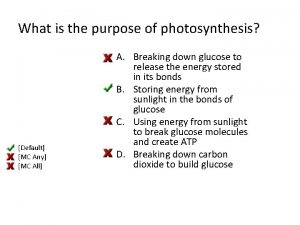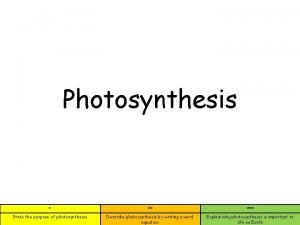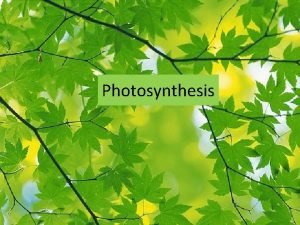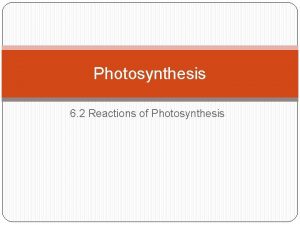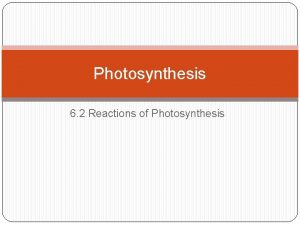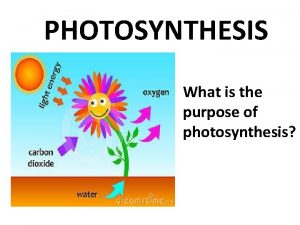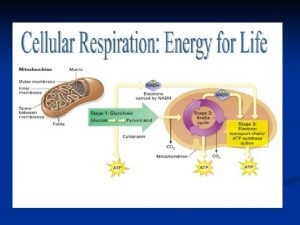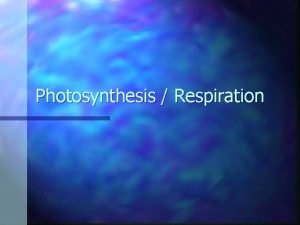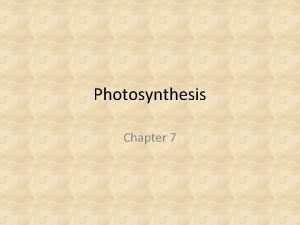What is the purpose of photosynthesis Default MC
![What is the purpose of photosynthesis? [Default] [MC Any] [MC All] A. Breaking down What is the purpose of photosynthesis? [Default] [MC Any] [MC All] A. Breaking down](https://slidetodoc.com/presentation_image/37f2168e48d9ee53c73b676ae7792969/image-1.jpg)

















- Slides: 18
![What is the purpose of photosynthesis Default MC Any MC All A Breaking down What is the purpose of photosynthesis? [Default] [MC Any] [MC All] A. Breaking down](https://slidetodoc.com/presentation_image/37f2168e48d9ee53c73b676ae7792969/image-1.jpg)
What is the purpose of photosynthesis? [Default] [MC Any] [MC All] A. Breaking down glucose to release the energy stored in its bonds B. Storing energy from sunlight in the bonds of glucose C. Using energy from sunlight to break glucose molecules and create ATP D. Breaking down carbon dioxide to build glucose

The Process of Photosynthesis A very simplified version of how it works

Learning Objective Identify: products and reactants of photosynthesis structures in which photosynthesis occurs.

Photosynthesis and Cellular Respiration Investigation Safety goggles must be worn at all times! Be careful while using straws! Gently blow into the test tube just enough to get the solution to bubble. DO NOT SUCK UP THE SOLUTION!

Photosynthesis and Cellular Respiration Investigation Universal p. H Indicator Red/Orange when acidic. Blue/Green when basic.

Photosynthesis and Cellular Respiration Investigation Part 1 Move to your lab tables and use the handout to complete the first part of the investigation.

Photosynthesis! All energy for the planet comes from the _______ are organisms that can convert light energy to chemical energy (food). This process is called photosynthesis and can be summarized in the following equation: light energy 6 H 2 O + 6 CO 2 6 O 2+ C 6 H 12 O 6


Photosynthesis takes place in the _______ of plant cells and consists of 2 sets of reactions. Light _______ reactions take place in the thylakoid and use water and light energy. Oxygen is a product of these reactions. Light _______ reactions take place in the stroma and use carbon dioxide. monosaccharides are a product of this reaction.

Light Dependent Reactions Sunlight energy is absorbed by ______ molecules in the thylakoids The electrons in chlorophyll molecules jump to an excited and unstable state in energy, which causes them to go down an electron transport gradient, releasing energy at each step This energy is used to form molecules of ____ from ADP +P The “excited” electrons also cause _______ molecules to split apart into hydrogen and oxygen ions Oxygen atoms are released and combine together to form ___ molecules. Hydrogen ions bind with NADP to become _____

Light Dependent Summary

Light Independent Reactions (Calvin Cycle) Carbon dioxide molecules have diffused into the _______ releases the hydrogen ions (NADPH NADP) In a series of reactions carbon dioxide molecules, hydrogen ions, and electrons are combined to form one _____ molecule ATP generated in the light _____ reaction is used to power the light ______ reaction (ATP ADP + released energy) NADP and ADP return to the _____

Light Independent Summary

Photosynthesis

Where do the light dependent reactions take place? A. Stroma B. Thylakoid

What molecules must be present for the light independent reactions to occur? A. Carbon Dioxide only B. Water, NADP+, ADP C. Carbon Dioxide, ATP, NADPH D. Water, Carbon Dioxide, Sunlight

Photosynthesis and Cellular Respiration Investigation Part 2 Move back to your lab groups and complete the rest of the handout. Finish the questions on the back of the handout after your lab table is clean.

Closing Turn in your completed investigation handout
 Purpose of photosynthesis
Purpose of photosynthesis The purpose of photosynthesis is
The purpose of photosynthesis is Purpose of photosynthesis
Purpose of photosynthesis Sơ đồ cơ thể người
Sơ đồ cơ thể người Cong thức tính động năng
Cong thức tính động năng Bảng số nguyên tố
Bảng số nguyên tố Tỉ lệ cơ thể trẻ em
Tỉ lệ cơ thể trẻ em đặc điểm cơ thể của người tối cổ
đặc điểm cơ thể của người tối cổ Các châu lục và đại dương trên thế giới
Các châu lục và đại dương trên thế giới ưu thế lai là gì
ưu thế lai là gì Thẻ vin
Thẻ vin Môn thể thao bắt đầu bằng chữ đua
Môn thể thao bắt đầu bằng chữ đua Tư thế ngồi viết
Tư thế ngồi viết Cái miệng nó xinh thế chỉ nói điều hay thôi
Cái miệng nó xinh thế chỉ nói điều hay thôi Hình ảnh bộ gõ cơ thể búng tay
Hình ảnh bộ gõ cơ thể búng tay Mật thư anh em như thể tay chân
Mật thư anh em như thể tay chân Từ ngữ thể hiện lòng nhân hậu
Từ ngữ thể hiện lòng nhân hậu Trời xanh đây là của chúng ta thể thơ
Trời xanh đây là của chúng ta thể thơ Tư thế ngồi viết
Tư thế ngồi viết
